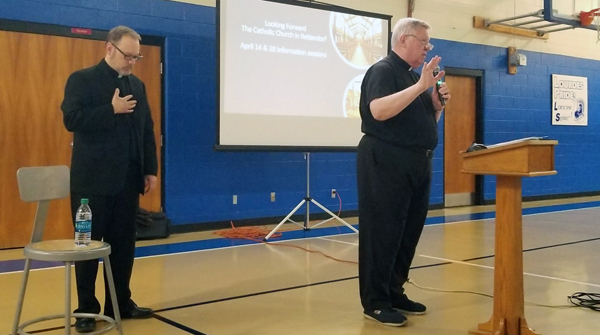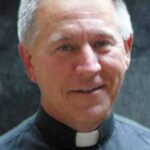
Father Jason Crossen, left, pastor of Our Lady of Lourdes Parish, and Father Jim Vrba, pastor of St. John Vianney Parish, both in Bettendorf, pray at the start of an informational meeting to discuss potential options for the parishes and Lourdes Catholic School on April 28 in the school gymnasium.
By Anne Marie Amacher
The Catholic Messenger
BETTENDORF — Five options for the future of the Catholic Church in the Bettendorf area have been presented to the public. Now, those who attended two separate meetings last month are invited to share their opinions about the next best step for the Catholic faith community in this growing city of 35,727.
During meetings held April 14 at St. John Vianney Parish and April 28 at Our Lady of Lourdes Parish, the Bettendorf Catholic Study Committee identified the five scenarios, which could change based on further input. Pros and cons have been identified for each option. The scenarios:
• Relocate Our Lady of Lourdes Parish and Lourdes Catholic School to north/northeast Bettendorf.
• Renovate and update the current facilities at their present locations.
• Combine Our Lady of Lourdes Parish and school and St. John Vianney Parish and relocate.
• Make no change. Maintain the current facilities.
• Relocate Lourdes Catholic School only. The parishes would remain in their current locations.
Father Jason Crossen, pastor of Our Lady of Lourdes, said the two informational meetings were just that: informational. “There are no mandates by the bishop or diocese.” Father Jim Vrba, St. John Vianney’s pastor, said the presentations shared “where we are at and looking to the future.”
Fr. Crossen said Lourdes school and the parish engaged in the strategic planning process between 2016 and 2017. Needs and initiatives aimed at furthering their respective missions were identified. At that time, three options were considered: do nothing, remodel/renovate or relocate and build new facilities. Because the third option had the potential to impact the Catholic Church in the wider Quad-Cities area, Bishop Thomas Zinkula was consulted early in the process.
After consulting with diocesan advisors, he asked that a committee be formed to “study the needs of the Catholic Church in Bettendorf for the best growth and development for the well-being of the church.” The bishop also asked that the Davenport Deanery be consulted in general, along St. John Vianney Parish and Our Lady of the River Parish in LeClaire. Also consulted were Diocesan Superintendent of Schools Lee Morrison and the Scott County Catholic School Advisory Board.
A committee of more than 30 members formed, representing the Bettendorf and LeClaire parishes and Assumption High School in Davenport. The committee was tasked with gathering information and data regarding population and growth in the city of Bettendorf and to discuss how that growth affects the larger Catholic community of Bettendorf.
During the April 28 meeting at Lourdes, Bettendorf Alderman Greg Adamson said the city is growing “north and east. The roundabout is going to be the center of town someday.”
Demographics
Nikki Gartner, a member of the study committee, said both parishes are financially sound. She provided information on the makeup of the parishes and school. Both parishes are consistently in the top 5 in financial support of the Annual Diocesan Appeal. She also provided statistics on sacraments at both parishes.
• Our Lady of Lourdes Parish reports 1,142 families with church seating capacity of 550. The number of families registered at Lourdes has decreased 20 percent since 1999.
• St. John Vianney Parish reports 1,956 families with church seating capacity of 1,000. The number of families has grown 49 percent since 1999. It is currently the largest parish in the Diocese of Davenport.
• Enrollment at Lourdes Catholic School has decreased 40 percent since 2000, the study showed. During the 2017-18 academic year, the school served 230 K-8 students, of which 179 (78 percent) were members of Our Lady of Lourdes Parish; 32 students (14 percent) are members of St. John Vianney Parish and 19 students (8 percent) are members of other parishes or not members of any parish. During 2017-18, Assumption High School enrollment for Our Lady of Lourdes and St. John Vianney was 47 and 15, respectively.
• Between 1999 and 2017, St. John Vianney saw a 36.5 percent increase in the number of baptisms celebrate per year. For that same period, Lourdes saw a 42 percent decrease. The data shows that on average, 68 new Catholics are baptized each year at St. John Vianney Parish while roughly 50 are baptized at Our Lady of Lourdes Parish.
• The number of Catholics receiving first Communion has declined at both parishes: down 56 percent at Our Lady of Lourdes and 6 percent at St. John Vianney. The number of marriages celebrated has also declined slightly at each parish. An average of 16-17 couples marries each year at Our Lady of Lourdes and at St. John Vianney.
Father Chris Weber, Our Lady of Lourdes’ parochial vicar, made an overlay of maps to provide a visual guide of where families in each parish live. The two Bettendorf parishes serve the same areas from west Davenport to LeClaire, up toward Long Grove and on the Illinois side of the river.
Needs
A facilities’ assessment of Lourdes found many issues need to be addressed, Fr. Crossen said. Among the issues: lack of a sprinkler system in case of a fire, heating and air conditioning challenges, power distribution is poor for today’s electronic needs. Asbestos and masonry problems exist; the school is not handicapped accessible and a new roof is needed. He expects sound issues related to completion of the new Interstate 74 Bridge. Another challenge: the parish is landlocked.
St. John Vianney is also landlocked, Fr. Vrba said. The parish recently completed a priority plan. “This is a roadmap for the next three to five years.” Some issues that arose: the need for a sound system upgrade, new roof, carport repairs, a new HVAC unit in the near future. Also, the parish has a shortage of religious education space and choir space for growing ministries. More parking is needed.
So where do we go from here?
Fr. Crossen said the committee and pastors hope that as many Catholics as possible from the parishes will work together to decide what is best for the Bettendorf Catholic community. “This has to be a communal effort,” he said, noting that any decision is dependent on support.
A feasibility study will be undertaken. “We all need to be transparent and take part. Not everyone will be happy.” The study, expected to take six to eight months, will look at the scenarios; see which way people are leaning and what could be raised financially. “By this time next year we will have direction,” Fr. Crossen predicted.
Q&A
A brief question and answer session followed each meeting. At the St. John Vianney meeting, one person asked if land had been purchased. Fr. Crossen said no. But there have been talks about the cost of land in northeast Bettendorf and what might be available.
Another person asked if either parish or the school could build higher on their current facilities. Fr. Vrba said no. The buildings were not planned or built to take the weight of additional classrooms or other facilities. Fr. Crossen agreed.
One parishioner asked about how a move would affect parish numbers, especially if Bettendorf continues to grow. Fr. Vrba said it’s hard to predict how many people would move to Bettendorf, how many are Catholic and how many would actually go to church. Fr. Crossen reminded those in attendance that going to the closest church is not what people typically choose. “They are looking for a home” and where they fit in.
How will the priest shortage affect the Bettendorf parishes? Fr. Crossen said the diocese has 65 active priests. Ten years from now, there will be 47 active priests — if no priest retires earlier than expected, no one dies while an active priest and no one takes a leave of absence. The estimate assumes an ordination rate of one to two priests each year.
One attendee at the Lourdes meeting asked if combining Lourdes and St. John Vianney could result in “too big a parish.” Fr. Vrba commented that a 3,000-family parish would have to focus on smaller communities within the bigger one so people wouldn’t feel lost. “Bigger isn’t always better that way,” he said.
Several parents and teachers, including a public school teacher, expressed optimism that a new school building could help draw more students into Catholic education, therefore drawing more people into the church. Fr. Crossen responded, “I think we’d be more competitive,” especially if the school were more centrally located.
(Reporter Lindsay Steele contributed to this article.)











